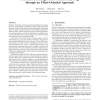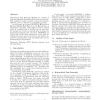90 search results - page 4 / 18 » Detecting interleaving |
ASPLOS
2010
ACM
15 years 6 months ago
2010
ACM
Multicore technology is making concurrent programs increasingly pervasive. Unfortunately, it is difficult to deliver reliable concurrent programs, because of the huge and non-det...
CAV
2010
Springer
2010
Springer
Universal Causality Graphs: A Precise Happens-Before Model for Detecting Bugs in Concurrent Programs
15 years 1 months ago
Triggering errors in concurrent programs is a notoriously difficult task. A key reason for this is the behavioral complexity resulting from the large number of interleavings of op...
106
click to vote
ACSC
2009
IEEE
15 years 6 months ago
2009
IEEE
Hierarchical Task Networks (HTNs) are a family of powerful planning algorithms that have been successfully applied to many complex, real-world domains. However, they are limited t...
SIGSOFT
2008
ACM
15 years 12 months ago
2008
ACM
NesC is a programming language for applications that run on top of networked sensor nodes. Such an application mainly uses an interrupt to trigger a sequence of operations, known ...
69
Voted
VMCAI
2004
Springer
15 years 4 months ago
2004
Springer
Abstract. This paper presents history-dependent scheduling, a new technique for reducing the search space in the verification of cryptographic protocols. This technique allows the...


